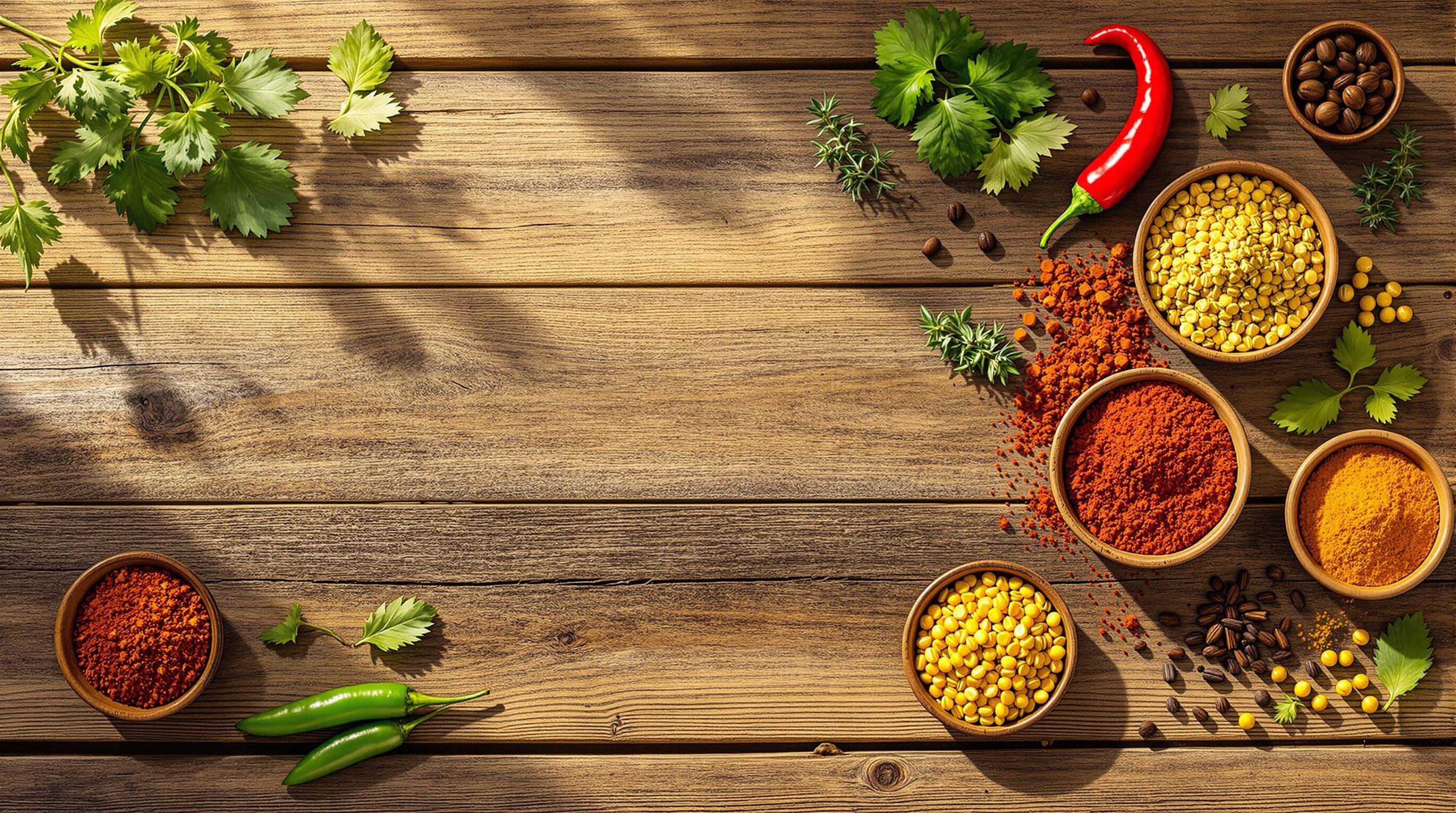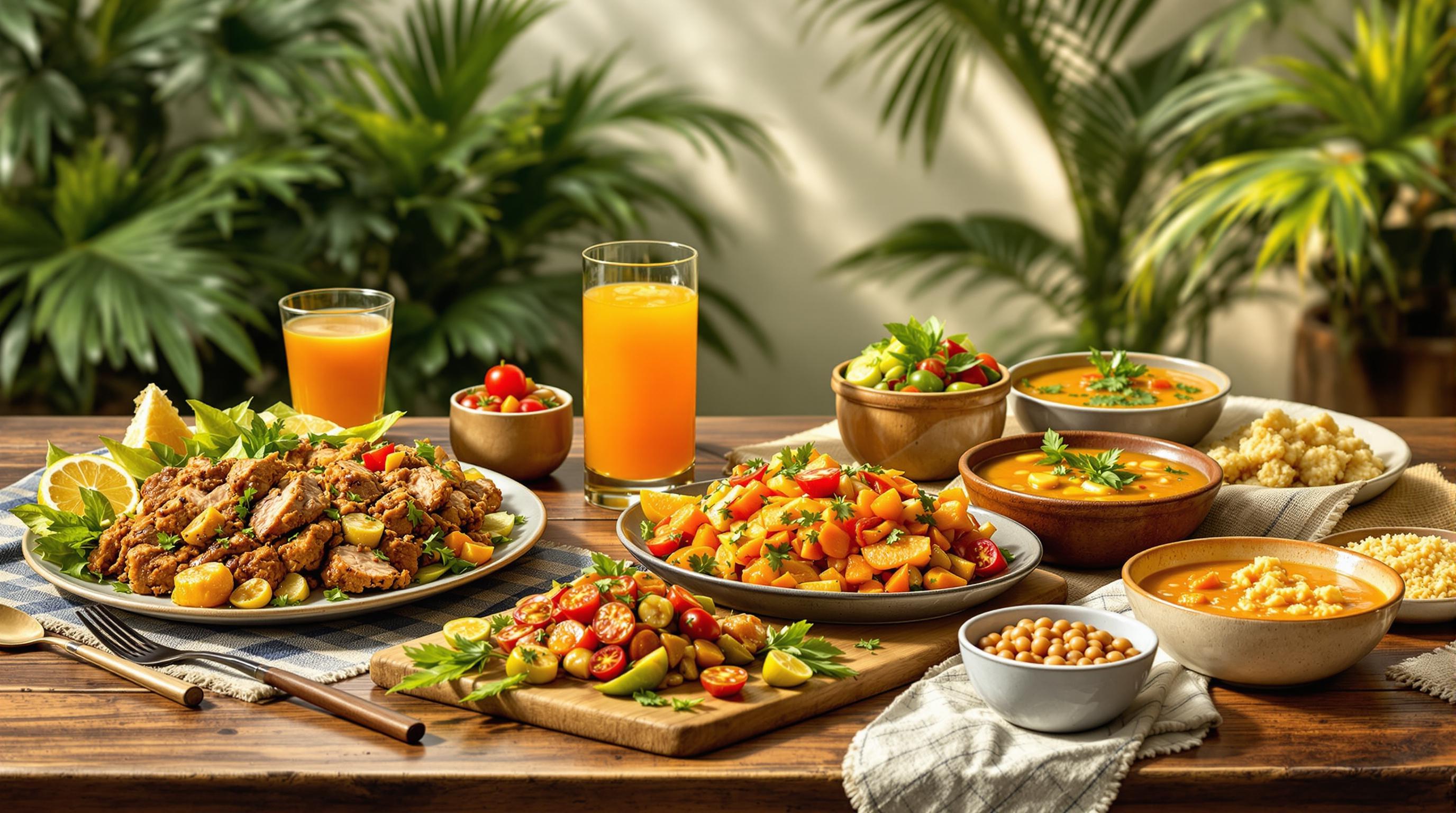Haitian cuisine is all about bold flavors, rich history, and cultural storytelling through food. Here's what makes it stand out:
- Epis: A versatile seasoning blend of thyme, parsley, garlic, scallions, and Scotch bonnet peppers forms the base of most dishes.
- Key Dishes: Must-tries include Griot (fried marinated pork), Soup Joumou (a squash soup symbolizing independence), and Bouillon (a hearty stew).
- Cooking Techniques: Slow marination, frying, and layering of spices create deep, complex flavors.
- Historical Influences: A mix of African, French, Spanish, and Indigenous traditions shaped the ingredients and methods.
Whether it's the spicy kick of Scotch bonnet peppers or the citrusy tang of marinated meats, Haitian food offers a unique taste of history and community. Dive in to explore its flavors and traditions!
10 HAITIAN FOODS You Must Try!
History and Origins
Haitian cuisine has developed over centuries, shaped by a blend of cultural influences that have left their mark on its distinctive flavors. One of the most essential elements in Haitian cooking today is the epis blend, a cornerstone seasoning that reflects this rich history.
The Taíno people contributed foundational ingredients like corn, sweet potatoes, papayas, guavas, and manioc flour, which they fermented to make bread. Later, during the colonial period, French and Spanish settlers introduced crops such as cocoa, coffee, and sugarcane, grown on large plantations. French influence is still evident in the popularity of cheeses and intricate desserts in Haitian markets.
Enslaved Africans brought with them okra, taro, rice, beans, and a variety of spices, which significantly transformed the culinary landscape of Haiti.
"Haitian food culture is an expression of identity, resilience, and community. It is the way we honor our history, celebrate life, and connect with each other. It's not just about food - it's about storytelling, pride, and preserving a legacy that blends African, Indigenous, French, and Caribbean influences." – Nadege Fleurimond
Today, Haitian cooking remains deeply tied to these historical roots while also embracing modern interpretations. Up next, we’ll dive into the key ingredients and seasonings - like the iconic epis - that define these flavors.
Main Ingredients and Flavors
Epis: The Base Seasoning
Epis is the backbone of Haitian cooking. This versatile blend typically includes fresh parsley, garlic, scallions, thyme, bell peppers, and, for those who like heat, Scotch bonnet peppers. While traditionally prepared using a mortar and pestle (pilon), many families now opt for food processors, often adjusting the recipe to reduce waste.
"In Haiti, epis is on an about-to-cook basis… It's a ritual in many households to call the kids to come pile epis (pound the epis) as the adults clean and prep the meats and other cooking essentials." – chef Nadege Fleurimond, Fleurimond Catering
Common Ingredients
Haitian cuisine relies on a variety of staples, including rice, beans, fish, chicken, beef, garlic, parsley, scallions, thyme, bell peppers, Scotch bonnet peppers, cloves, vinegar, and lime juice. These ingredients form the foundation of many dishes.
Spice Differences in Caribbean Cooking
Haitian flavors stand out among Caribbean cuisines due to their rich history and diverse influences.
"Unlike any other Caribbean country, Haiti's cuisine is complex because of the slave trade, migration, spices trade, and more. We have heavy African, French, Spanish, and even Middle Eastern influences, which create a very unique blend of flavors. But, if we are to describe what the key ingredients are in Haitian cuisine, I'll say thyme, cloves, and hot peppers." – Chef Alain Lemaire
Haitian recipes often combine epis with thyme, cloves, and Scotch bonnet peppers in marinades, stews, and soups, creating layers of bold, spicy flavors. These essential seasonings bring depth and character to Haiti's most celebrated dishes.
Next, dive into how these ingredients shine in iconic Haitian recipes and traditional cooking techniques.
sbb-itb-80c33ff
Popular Dishes and Methods
Haitian cuisine stands out with its iconic dishes and distinct cooking techniques, all rooted in its rich blend of flavors and traditions.
Must-Try Haitian Dishes
One standout is Griot, featuring pork cubes marinated in citrus, chilies, and onions, simmered until tender, then fried to create a crispy, tangy, and spicy crust. Another beloved dish is Soup Joumou, a hearty squash-based soup that symbolizes Haitian independence. This dish combines tender beef, a variety of vegetables, and aromatic spices like chilies, cloves, thyme, and parsley. Other favorites include bouillon (a beef and seafood stew with potatoes), mais moulin (a creamy cornmeal porridge), and Haitian-style spaghetti. Each dish reflects Haiti's cultural fusion of African, French, and Indigenous influences.
Cooking Methods
Haitian cooking often begins with meticulous preparation. Meats are cleaned by rinsing in a mix of vinegar and water, then marinated with salt, citrus juice, and a blend of seasonings. A key ingredient in many recipes is epis, a flavorful seasoning base that adds depth. The marination process usually lasts for several hours or overnight to enhance flavor.
For dishes like Soup Joumou, marinated beef is simmered in broth until tender, while squash is cooked separately and pureed. Gradually, vegetables like cabbage, celery, potatoes, and turnips are added alongside seasonings such as onion powder, garlic powder, cayenne, pepper, and thyme. Butter, oil, and vinegar are incorporated as the dish simmers on medium-low heat, allowing the flavors to meld.
Frying is another hallmark of Haitian cooking. Meats are often cooked in their marinades until tender before being fried, creating bold and contrasting flavors that are a signature of Haitian cuisine.
Where to Find Haitian Food
Haitian cuisine is becoming easier to find in cities across the U.S. Here’s a guide to enjoying these bold and flavorful dishes outside your home kitchen.
Top Restaurants
South Florida, home to vibrant Haitian communities, is a hotspot for Haitian dining. Here are some standout options in Miami and Fort Lauderdale:
- Naomi's Garden Restaurant & Lounge (Liberty City, Miami): Famous for its lively vibe and classic Haitian-Caribbean dishes.
- Chef Creole Seasoned Restaurant (Miami): Combines Caribbean flavors with a Creole influence.
- Le Jardin Haitian Restaurant (Little River, Miami): Known for specialties like griot and legume.
- Cecibon Restaurant (Miami and Fort Lauderdale): Offers staples such as griot, tassot, and legume.
What to Look For
To ensure you’re getting authentic Haitian food, keep these tips in mind:
- Specialized Menus: Restaurants focusing solely on Haitian dishes are more likely to deliver traditional flavors.
- Signature Dishes: Look for items like griot, tassot, and legume made with traditional epis (a seasoning blend) and marinades. Online reviews can also provide helpful insights.
Conclusion
Haiti's cuisine stands out for its bold flavors, shaped by rich seasoning blends like epis, which brings together ingredients like thyme, cloves, and hot peppers. Techniques such as slow braising, marination, and frying create the layered tastes found in dishes like crispy griot and the iconic Soup Joumou. Each dish reflects Haiti's history, resilience, and vibrant traditions. Trying Haitian food is more than enjoying a meal - it's an invitation to experience the essence of its culture and community.


